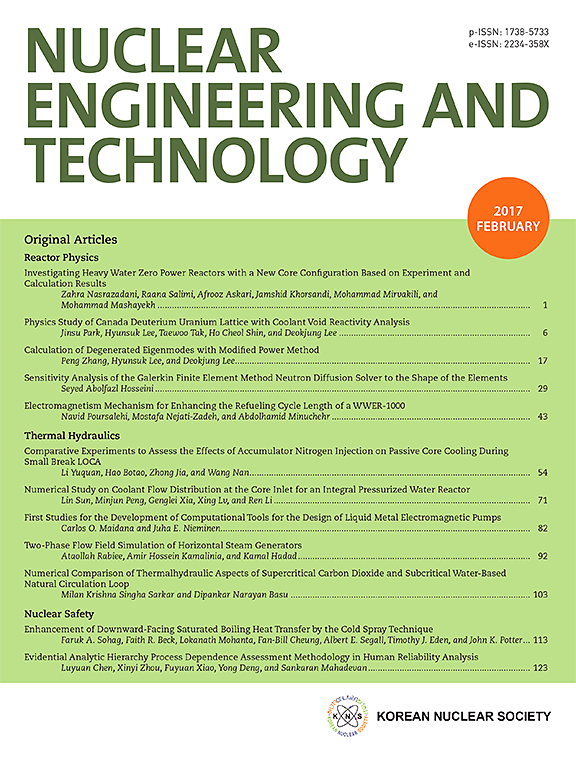Kinetic simulation of uranium migration in granite fissure media of beishan, gansu, China: A case study based on the Laplace transform and inverse transform methods
IF 2.6
3区 工程技术
Q1 NUCLEAR SCIENCE & TECHNOLOGY
引用次数: 0
Abstract
Deep geological disposal is currently considered the most practical and feasible method for disposing high-level radioactive wastes (HLWs). One of its key scientific issues is the migration of nuclides in fissure media. However, studies on the migration of nuclides like U-238 are relatively limited. In this study, the granite rock masses in Beishan, Gansu were selected to construct a physical and mathematical model of U-238 migration using the Laplace transform and inverse transform methods. Based on the numerical methods, the kinetic migration of nuclide U-238 in the fissure media of granite was simulated, and the effects of parameters such as fissure width, hydraulic gradient, diffusible area ratio and rock porosity on the migration of U-238 were investigated. The following insights were obtained: (1) After 100,000 years, U-238 has a very limited diffusion depth in the matrix domain, with a diffusion range of only a few tens of millimeters, whereas it migrates relatively quickly in the fissure domain, with a maximum migration distance of about 1500 m. (2) Under the same migration time and distance, the relative concentration of nuclide U-238 in the fissure domain increases with larger gap width, hydraulic gradient, and diffusible area ratio, but decreases with higher rock porosity. (3) In the same time range, the rock masses with larger gap widths, hydraulic gradients, and diffusible area ratios have larger migration ranges, while those with higher porosities have smaller migration ranges. (4) While selecting a site for diposal of HLWs, it is recommended to choose rock masses in the granite area of Beishan with no fissures or few fissures; additionally, areas with smaller fissure widths, hydraulic gradients, and diffusible area ratios but higher rock porosity should be prioritized. This study can provide important theoretical support for understanding nuclide migration in the future geological disposal of HLWs.
中国甘肃北山花岗岩裂隙介质中铀迁移的动力学模拟:基于拉普拉斯变换和反变换方法的案例研究
深层地质处置目前被认为是处置高放射性废物(HLWs)最切实可行的方法。其关键科学问题之一是核素在裂隙介质中的迁移。然而,对铀-238 等核素迁移的研究相对有限。本研究选取了甘肃北山的花岗岩岩体,利用拉普拉斯变换和反变换方法构建了铀-238 迁移的物理和数学模型。基于数值方法,模拟了核素铀-238在花岗岩裂隙介质中的动力学迁移,研究了裂隙宽度、水力梯度、可扩散面积比和岩石孔隙度等参数对铀-238迁移的影响。结果表明:(1)10 万年后,铀 238 在基质域的扩散深度非常有限,扩散范围只有几十毫米,而在裂隙域的迁移速度相对较快,最大迁移距离约为 1500 米;(2)在相同的迁移时间和迁移距离下,裂隙域核素铀 238 的相对浓度随裂隙宽度、水力梯度和可扩散面积比的增大而增大,但随岩石孔隙度的增大而减小。(3) 在同一时间范围内,岩隙宽度、水力梯度和可扩散面积比越大的岩体,其迁移范围越大,而孔隙度越高的岩体,其迁移范围越小。(4) 北山花岗岩地区的岩体,建议选择无裂隙或裂隙较少的岩体,并优先选择裂隙宽度、水力梯度和可扩散面积比较小,但岩石孔隙度较高的地区作为高放射性废物的倾弃场。这项研究可为了解未来高放射性废物地质处置过程中的核素迁移提供重要的理论支持。
本文章由计算机程序翻译,如有差异,请以英文原文为准。
求助全文
约1分钟内获得全文
求助全文
来源期刊

Nuclear Engineering and Technology
工程技术-核科学技术
CiteScore
4.80
自引率
7.40%
发文量
431
审稿时长
3.5 months
期刊介绍:
Nuclear Engineering and Technology (NET), an international journal of the Korean Nuclear Society (KNS), publishes peer-reviewed papers on original research, ideas and developments in all areas of the field of nuclear science and technology. NET bimonthly publishes original articles, reviews, and technical notes. The journal is listed in the Science Citation Index Expanded (SCIE) of Thomson Reuters.
NET covers all fields for peaceful utilization of nuclear energy and radiation as follows:
1) Reactor Physics
2) Thermal Hydraulics
3) Nuclear Safety
4) Nuclear I&C
5) Nuclear Physics, Fusion, and Laser Technology
6) Nuclear Fuel Cycle and Radioactive Waste Management
7) Nuclear Fuel and Reactor Materials
8) Radiation Application
9) Radiation Protection
10) Nuclear Structural Analysis and Plant Management & Maintenance
11) Nuclear Policy, Economics, and Human Resource Development
 求助内容:
求助内容: 应助结果提醒方式:
应助结果提醒方式:


